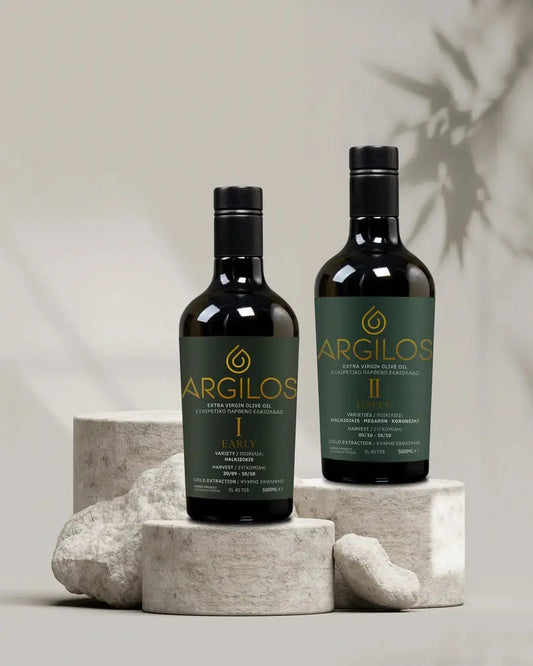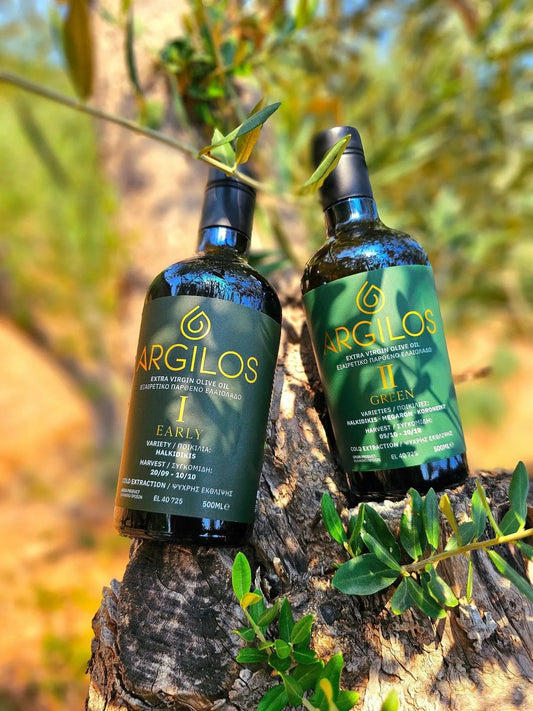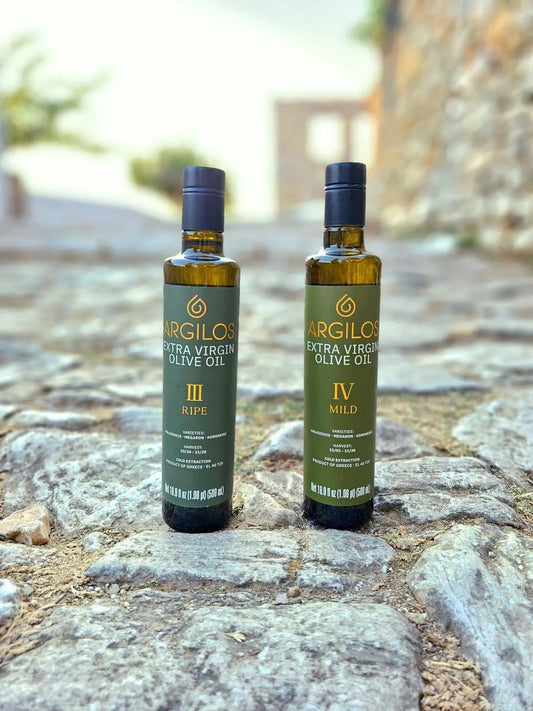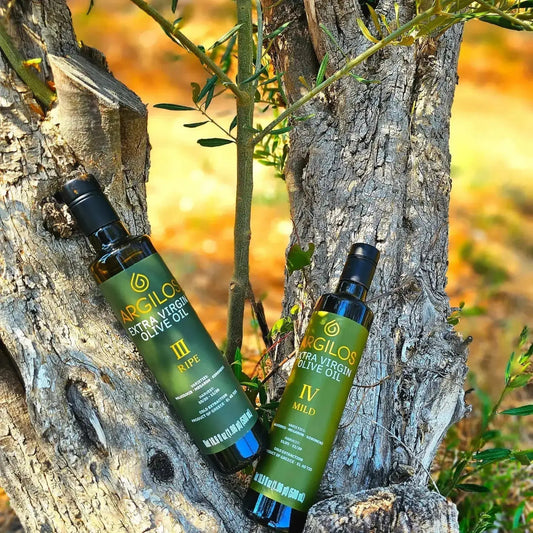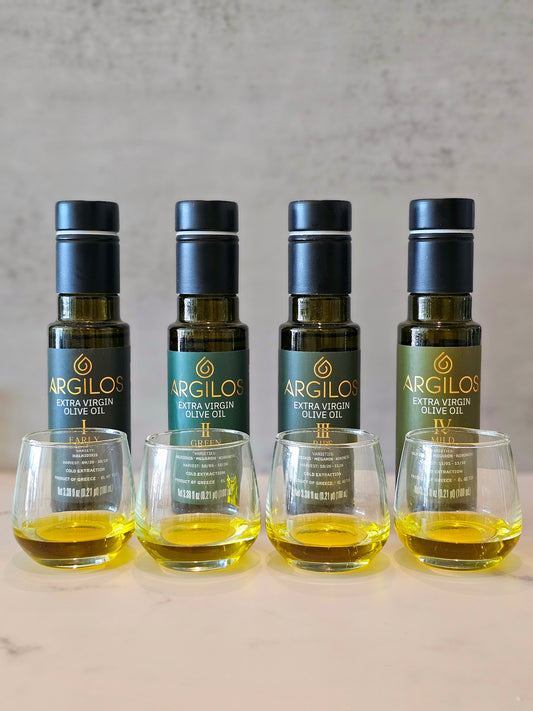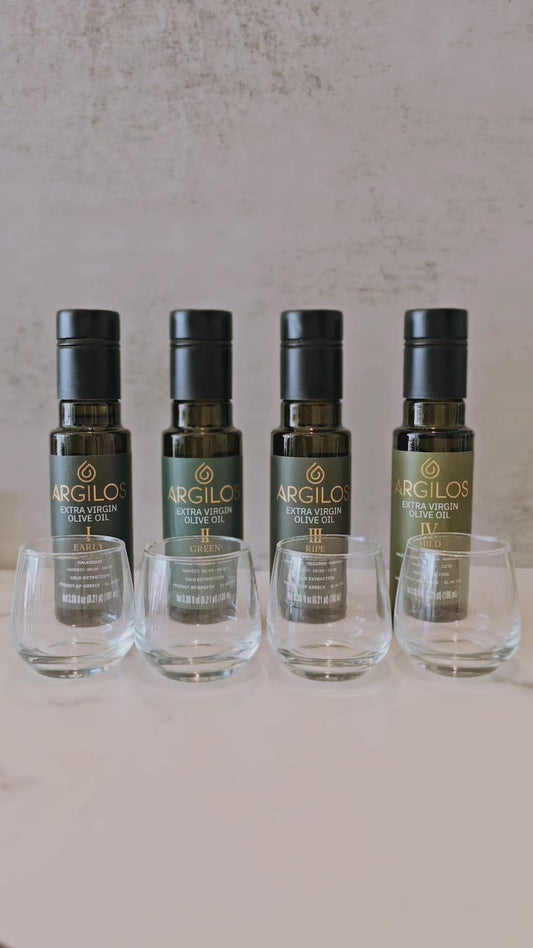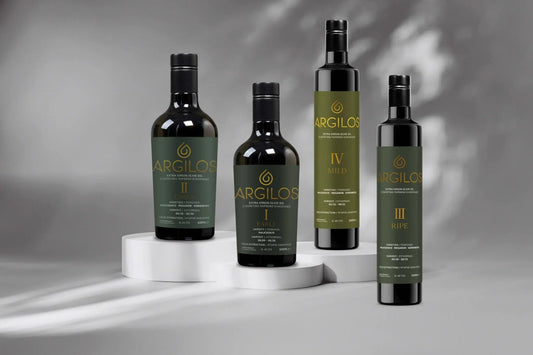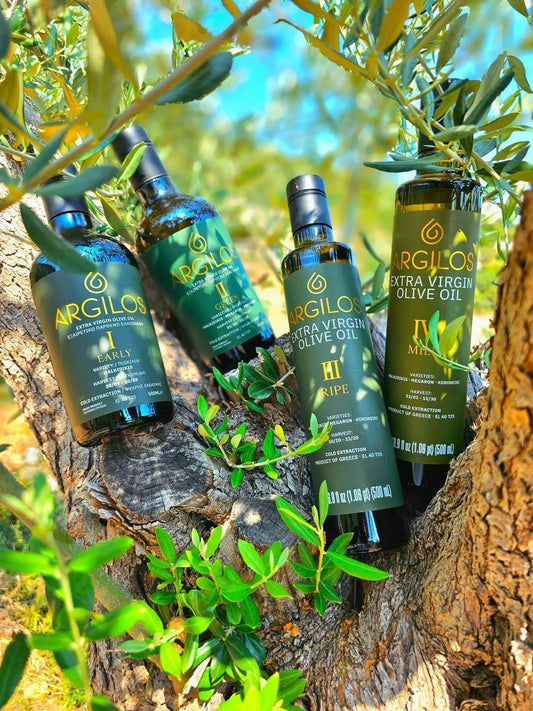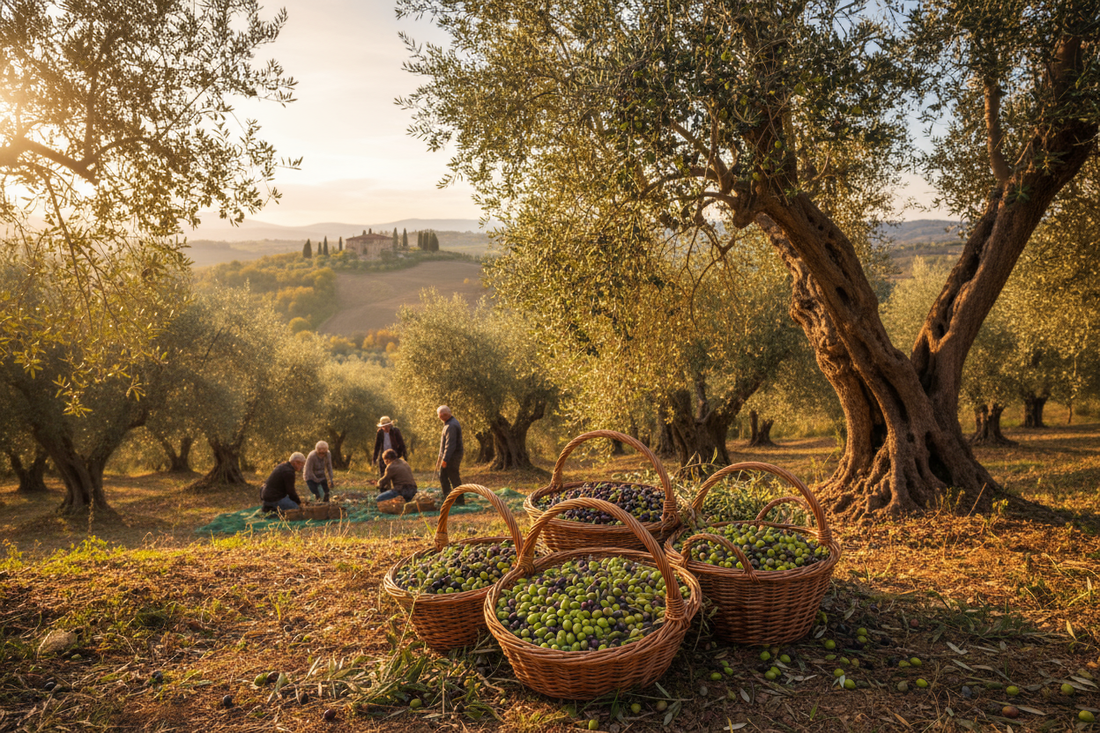
The Heart of Olive Harvest Season: Mastering Techniques for Premium Olive Oil Quality
Share
As late October unfolds across Mediterranean groves, the olive harvest season hits its stride, transforming ancient orchards into hubs of activity. This crucial period—typically spanning October to December—decides the fate of your extra virgin olive oil (EVOO), separating exceptional bottles from the ordinary. At Nostos Goods, we proudly produce and source our Argilos Greek Extra Virgin Olive Oil directly from family-run estates in Northern Greece, where time-honored traditions meet modern precision to capture olives at their peak ripeness. In this in-depth guide, we'll explore the principles of correct olive harvesting, how it elevates olive oil quality, and the meticulous olive oil making process. Whether you're a home cook, food enthusiast, or aspiring producer, understanding these elements will help you appreciate the golden elixir that enhances every meal.
Why Late October is the Sweet Spot for Olive Harvesting
Olive trees, icons of the Mediterranean landscape, flourish in sun-drenched climates with mild winters. The harvest window opens in early October for green olives and extends through December for riper ones, but late October often marks the "heart" of the season, especially for varieties like Halkidiki in Greece— the unique olive featured in our Argilos EVOO, which we're the only brand offering in the U.S.
Key Factors in Timing the Harvest
- Ripeness Stages: From Green to Veraison: Olives begin as vibrant green fruits packed with polyphenols, delivering that signature peppery kick and robust flavor. As they mature into purple-black hues during veraison, oil yields increase, but so does the risk of over-ripening, which can spike acidity and diminish quality. Harvest too soon, and you sacrifice volume; too late, and fermentation sets in, compromising freshness.
- Weather's Role: Cooler autumn nights in late October help lock in delicate aromas, while drier conditions reduce mold and pest threats. In regions like Mount Pangaion in Northern Greece, home to our Argilos olives 2025's mild weather forecasts bountiful, high-quality yields.
- Regional Nuances: In Greece, particularly Northern areas, harvests peak in mid-to-late October for bold, fruity profiles. This aligns perfectly with our single-origin approach, ensuring every bottle of Argilos reflects the terroir of Mount Pangaion.
Professional growers don't leave it to chance. They use scientific methods like iodine staining to assess sugar levels or refractometers for oil content. For backyard growers or small farms, a simple taste test works: ideal olives should have firm flesh with just-emerging color changes, balancing acidity and antioxidants.
Core Principles of Correct Olive Harvesting for Unmatched Oil Quality

The way olives are harvested profoundly affects the final product's integrity. Damaged fruit leads to rapid oxidation, elevating free fatty acids (FFA) and peroxides indicators of inferior oil prone to rancidity. At Nostos Goods, our partners adhere to rigorous standards to maintain the premium status of our Argilos EVOO, which is harvested and cold-pressed within hours for peak freshness.
1. Hand-Picking: Preserving Delicacy
This traditional method involves gently twisting or raking olives into nets below the trees. It's labor-intensive but minimizes bruising, keeping FFA levels ultra-low (below 0.3% for top-tier EVOO). Our Halkidiki olives from Mount Pangaion are hand-harvested this way, safeguarding their fruity, herbal, and peppery notes.
2. Mechanical Methods Done Right
For efficiency in larger groves, tree shakers or vibrators dislodge olives onto padded frames. The key is moderation over-vibration can include leaves, imparting unwanted bitterness from chlorophyll. When executed with care, this method rivals hand-picking in quality.
3. Net and Ground Collection Systems
Breathable nets or tarps catch naturally falling olives, but prompt collection is essential. Leaving them piled up invites heat buildup from respiration, accelerating spoilage. Best practice: Gather and sort within hours.
4. Swift Transport to the Mill
Post-harvest, olives are transported in ventilated crates to prevent crushing. Delays are the enemy beyond 24 hours, acidity can double. Our process at Nostos Goods ensures milling within hours, preserving the rich polyphenols that make Argilos a health powerhouse.
Expert Tip: Schedule harvests for cool early mornings (15-20°C or 59-68°F) to retain volatile compounds. These evoke sensory delights like fresh herbs, green almonds, and a subtle peppery finish hallmarks of our Argilos EVOO.
Impact of Harvest Timing on Olive Oil Quality: A Deep Dive
Quality isn't subjective; it's measured by standards from the International Olive Council (IOC), focusing on chemical composition and sensory evaluation. Early harvests in late October yield superior oils, as seen in our Argilos, which boasts high polyphenols for anti-inflammatory benefits.
| Quality Factor | Early Harvest (Green Olives, Late October) | Late Harvest (Ripe Olives, November-December) |
|---|---|---|
| Polyphenols | High (300-800 mg/kg) – Pungent, antioxidant-rich | Lower (100-300 mg/kg) – Smoother but less healthful |
| Acidity (FFA) | <0.2% – Exceptionally fresh and stable | 0.3-0.8% – Higher defect risks |
| Peroxide Value | Low (<10 meq O2/kg) – Minimal oxidation | Elevated with delays |
| Flavor Profile | Grassy, herbal, complex with peppery bite | Nutty, sweeter, but shorter shelf life |
| Oil Yield | 10-15% per kg of olives – Premium focus | 20-25% but compromised quality |
These metrics underscore why our Argilos, rich in polyphenols, stands out. Polyphenols like oleocanthal offer anti-inflammatory effects akin to ibuprofen, enhancing both flavor and wellness.
Step-by-Step: The Olive Oil Making Process Unveiled
From grove to bottle, olive oil production marries artistry and science. At Nostos Goods, we blend centuries-old Greek traditions with cutting-edge techniques for our single-origin Argilos.
Step 1: Cleaning and Preparation
Olives arrive at the mill and are sorted to remove leaves, twigs, and debris. A gentle cold-water rinse clears any residues, ensuring purity without compromising natural compounds.
Step 2: Crushing into Paste
Modern hammer or blade mills pulverize the olives—pits and all—into a paste. Traditional stone mills, still used in boutique settings, add a rustic touch but demand more time.
Step 3: Malaxation (Kneading)
The paste is slowly kneaded for 20-40 minutes at temperatures below 27°C (80°F). This "cold-pressing" step coalesces oil droplets without heat, preserving enzymes and earning the coveted "cold-pressed" designation.
Step 4: Extraction Methods
- Modern Centrifugation: A horizontal decanter spins out oil from water and solids efficiently, ideal for high-volume purity.
- Traditional Pressing: Hydraulic presses with mats produce artisanal oils, though they may need extra filtering.
Step 5: Final Separation and Filtration
A vertical centrifuge refines the oil further. While unfiltered oils have a trendy cloudy appeal, light filtration—like we recommend—extends shelf life by removing sediments.
Step 6: Storage and Bottling
Oil is stored in stainless steel tanks under nitrogen gas at cool 15°C to fend off oxidation. Our dark glass bottles shield against light, and each Argilos features a QR code for full traceability: scan to reveal harvest date, maturity index, and organoleptic details.
Avoiding Common Harvest Pitfalls for Flawless Results
Even seasoned producers slip up. Here's how to sidestep them:
- Ground Contact: Picks up dirt and bacteria, leading to musty flavors—always use elevated nets.
- Crate Overloading: Squashes olives, triggering enzymatic reactions and browning.
- Harvesting in Heat: Evaporates precious aromas; stick to dawn hours.
- Processing Delays: FFA rises by about 0.05% per hour—mill ASAP.
Proactive measures like shaded collection zones and on-site mills, as practiced for our Argilos, mitigate these risks.
Health and Culinary Benefits of Properly Harvested EVOO

Beyond taste, high-quality EVOO like Argilos supports heart health, reduces inflammation, and aids digestion thanks to its monounsaturated fats and antioxidants. In the kitchen, its fruity-herbal profile shines in drizzles over salads, dips for bread, or finishes for grilled meats. Experiment with our Olive Paste Quartet for spreads that capture the essence of Greek olives.
Discover Nostos Goods: Your Gateway to Authentic Greek EVOO
This late October, immerse yourself in the harvest spirit with Nostos Goods' Argilos Greek Extra Virgin Olive Oil. Sourced from the Halkidiki variety on Mount Pangaion, it's cold-pressed within hours for unmatched freshness and transparency. With four intensities to suit every palate, it's perfect for elevating fall dishes—from hearty stews to crisp salads—or as a thoughtful gift.
Shop Now: Argilos Greek Extra Virgin Olive Oil
Curious about the journey? Dive into our Argilos Olive Diary for behind-the-scenes harvest stories and tips. Subscribe to our newsletter for seasonal updates, exclusive recipes, and discounts. Embrace the Mediterranean tradition—one pour at a time.

